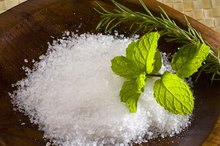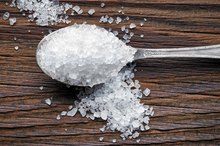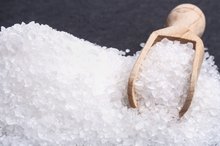What does fact checked mean?
At Healthfully, we strive to deliver objective content that is accurate and up-to-date. Our team periodically reviews articles in order to ensure content quality. The sources cited below consist of evidence from peer-reviewed journals, prominent medical organizations, academic associations, and government data.
- 9 out of 10 Americans eat too much sodium infographic. (2019).
- Mayo Clinic Staff. (2018). Bags under the eyes.
- Mayo Clinic Staff. (2018). Blocked tear duct.
- Mayo Clinic Staff. (2018). Graves' disease.
The information contained on this site is for informational purposes only, and should not be used as a substitute for the advice of a professional health care provider. Please check with the appropriate physician regarding health questions and concerns. Although we strive to deliver accurate and up-to-date information, no guarantee to that effect is made.
Sodium and Puffy Eyes
**If you have ever eaten a high-sodium meal and felt bloated afterward, you can begin to understand the effects sodium can have on your body 7. Not only can sodium cause your stomach to feel bloated, it also can make your eyes appear puffy. To reduce the incidence of puffy eyes, you can cut back on the sodium in your diet.
Sodium and Your Body
Your body requires sodium for a number of functions, which includes maintaining the proper fluid balance in your body. Your kidneys are the main fluid sensors for your body 2. They determine how much sodium you have in your body and retain or release water accordingly. If your sodium levels are high, your kidneys will signal your body to retain water, which can lead to bloating. This can apply to the area underneath your eyes because the skin under the eyes is very thin [3](https://www.mayoclinic.org/diseases-conditions/bags-under-eyes/symptoms-causes/syc-20369927 'inline-reference::Mayo Clinic Staff.
(2018). Bags under the eyes.'). **When your body retains water, the skin under your eyes may appear even more pronounced, leading to the appearance of puffy eyes 3.
- Your body requires sodium for a number of functions, which includes maintaining the proper fluid balance in your body.
- If your sodium levels are high, your kidneys will signal your body to retain water, which can lead to bloating.
Causes
Does Sodium Make Your Face Fat?
Learn More
Sodium is one of several contributing factors that can lead to puffy eyes. Being aware of the causes can help you reduce all behaviors that could potentially contribute to puffy eyes. This includes lack of sleep or sleeping flat on your back, which can cause fluid to pool underneath your eyes. Fluctuating hormone levels also can contribute to fluid retention. For example, if you are nearing the start of your menstrual cycle, changes in estrogen level may trigger fluid retention. Allergies and family history also can contribute to puffy eyes.
- Sodium is one of several contributing factors that can lead to puffy eyes.
- Being aware of the causes can help you reduce all behaviors that could potentially contribute to puffy eyes.
Prevention
While your body needs sodium to survive, you typically get enough in your daily diet without adding extra salt. If you experience sodium-related eye puffiness, you may need to cut back on foods known to contribute to fluid retention. This includes pre-packaged foods like frozen and canned foods. Sodium is frequently added as a preservative to these foods. Many restaurant and fast food meals tend to be high in sodium as well because salt is added to enhance flavor. Choosing fresh fruits and vegetables or preparing meals at home with minimal salt can help reduce your overall intake.
- While your body needs sodium to survive, you typically get enough in your daily diet without adding extra salt.
- Many restaurant and fast food meals tend to be high in sodium as well because salt is added to enhance flavor.
Solution
How Many Milligrams of Sodium Should I Have in One Day?
Learn More
If you experience eye puffiness that is related to sodium retention, there are some steps you can take to flush the sodium and fluid buildup from your body. The first is to gently tap the area underneath your eyes where the skin is puffy. This can encourage the fluid to drain. Flush the sodium from your body by increasing the amount of water you drink. The increase in water will dilute the salt in your body, signaling the kidneys to release fluid. You also can apply a cold compress like cooled cucumber or potato slices or a cloth dipped in milk. To your eyes and the area underneath your eyes for 10 minutes to reduce puffiness.
- If you experience eye puffiness that is related to sodium retention, there are some steps you can take to flush the sodium and fluid buildup from your body.
- To your eyes and the area underneath your eyes for 10 minutes to reduce puffiness.
Related Articles
References
- 9 out of 10 Americans eat too much sodium infographic. (2019).
- 8 reasons for your swollen eye or eyelid. (2016).
- Mayo Clinic Staff. (2018). Bags under the eyes.
- Mayo Clinic Staff. (2018). Blocked tear duct.
- Mayo Clinic Staff. (2018). Graves' disease.
- Sawant SP. (2017). Hoagland sign: An early manifestation of acute infectious mononucleosis: A case report.
- Sundelin T, et al. (2013). Cues of fatigue: Effects of sleep deprivation on facial appearance.DOI:
- Turbert D. (2018). What are eye allergies? (2019).
- American Heart Association. Sources of Sodium.
- Centers for Disease Control and Prevention. Top 10 Sources of Sodium. 2017.
- Institute of Medicine. Dietary Reference Intakes Tables and Application. National Academies of Sciences, Engineering, and Medicine, Health and Medicine Division. 2015.
- United States Department of Agriculture. Dietary Guidelines for Americans 2015–2020. United States Department of Health and Human Services. 2015.
Writer Bio
Rachel Nall began writing in 2003. She is a former managing editor for custom health publications, including physician journals. She has written for The Associated Press and "Jezebel," "Charleston," "Chatter" and "Reach" magazines. Nall is currently pursuing her Bachelor of Science in Nursing at the University of Tennessee.









